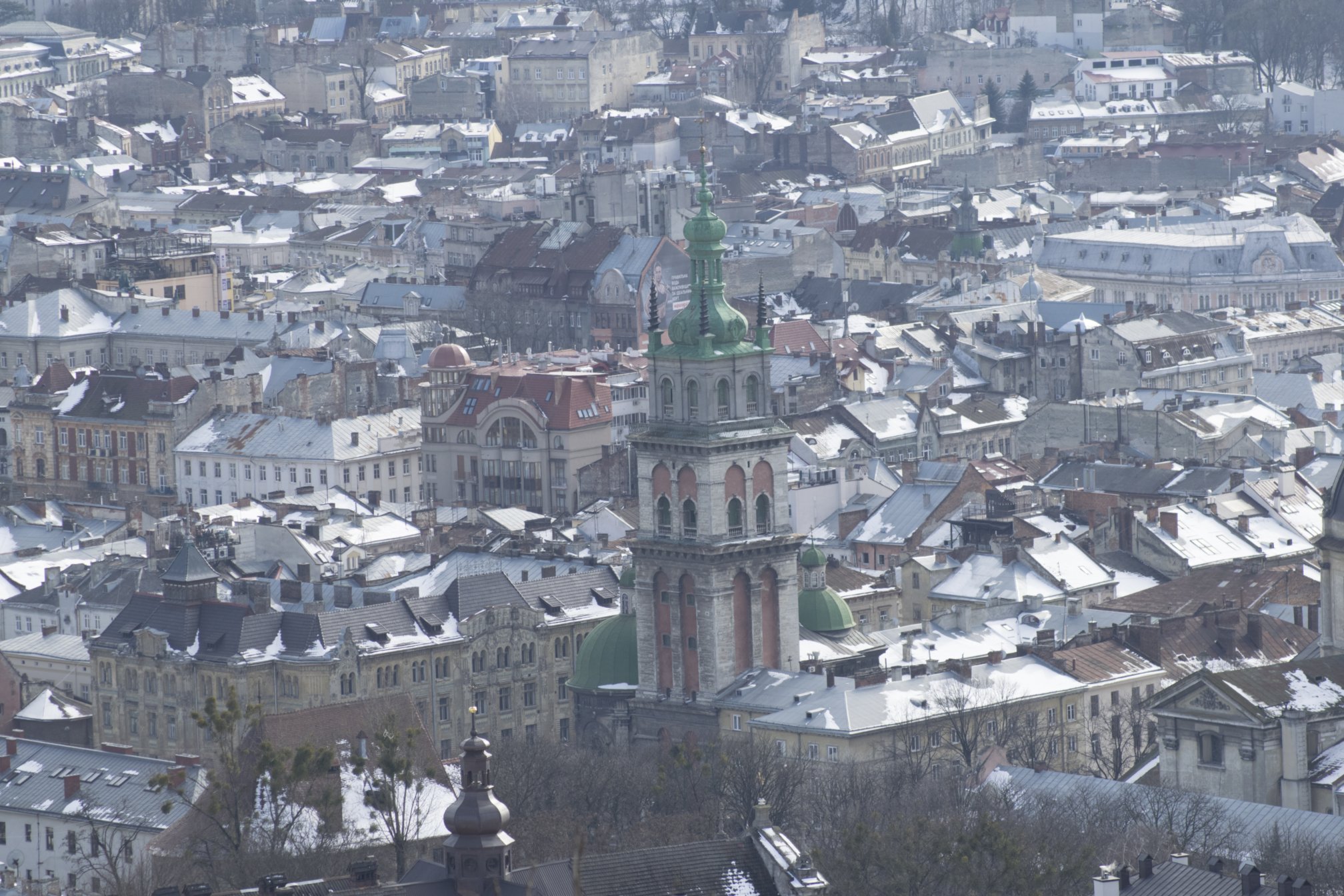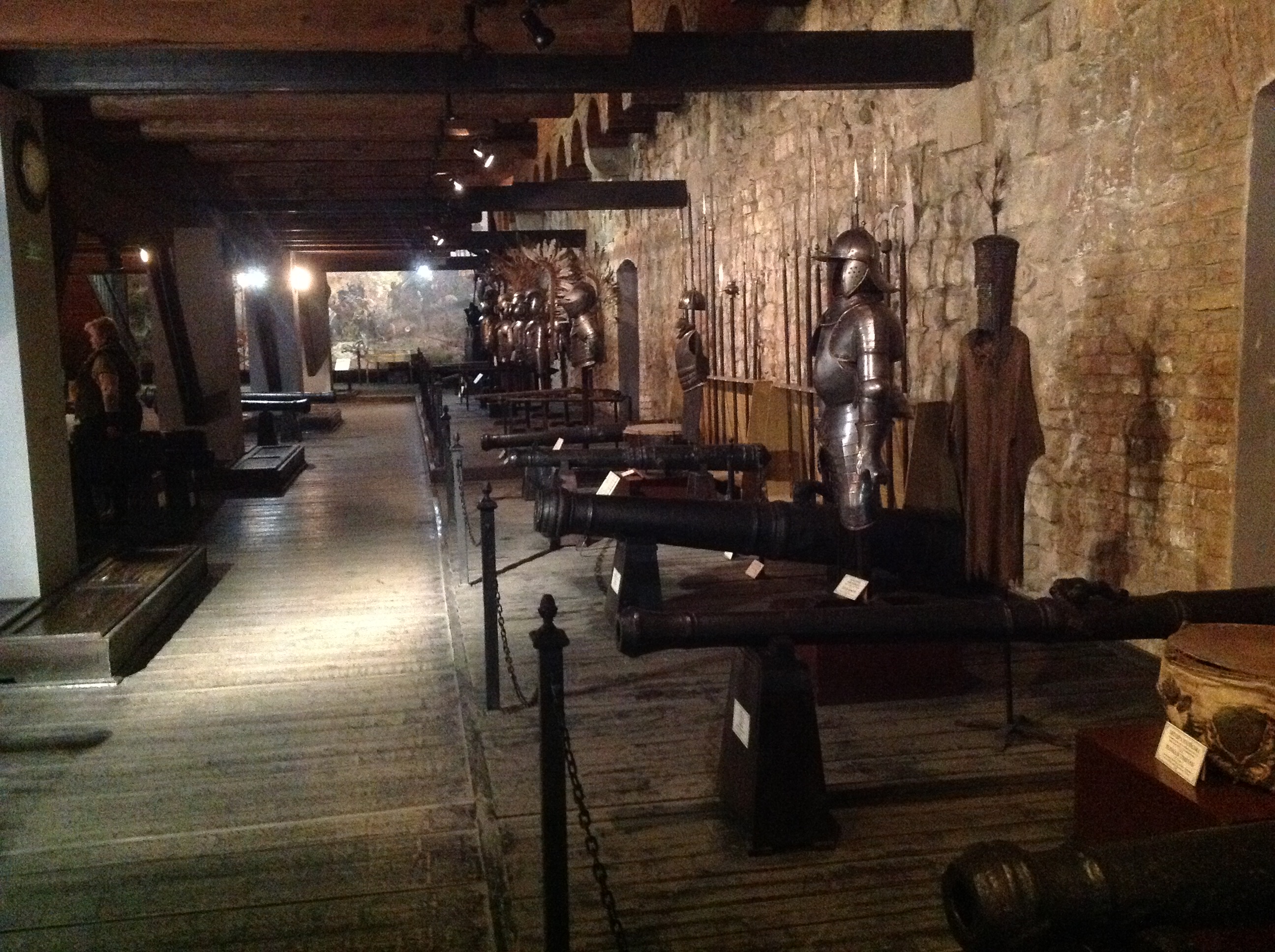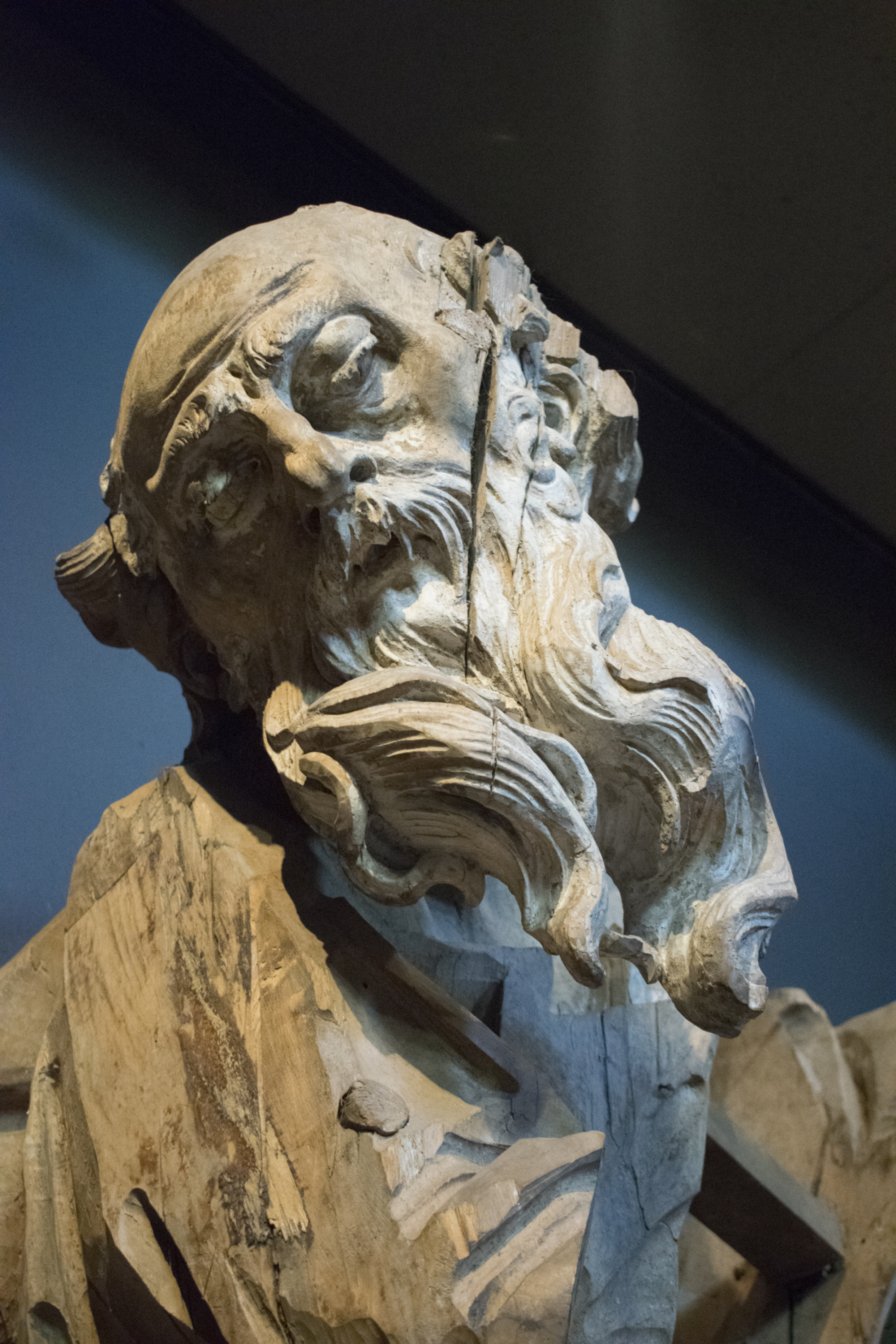Lviv sights
Ploshcha Rynok (Market Square).
 This architectural ensemble occupies a special place in the civil architecture of Lviv. In the center of the square (142 x 129 m) is the city hall. References to the square first appeared in the municipal acts of 1381, when the original wood structure was destroyed by fire. A new city hall was constructed in the 15th cent. In 1826 this structure collapsed; the present structure was built in 1827-35 by the architects A. Vondrashko, Y. Markl, F. Treter, and Yu. Hlohovsky. Its present appearance is the result of reconstruction undertaken following a fire in 1848. Many historical events have taken place on the Market Square. In Medieval times an execution pillar stood opposite the city hall. Here in 1564 the Moldovian Prince Tomsha was executed, followed by Ivan Pidkova in 1578. On 1 November 1918 the Ukrainian blue-and-yellow flag was raised at City Hall. The state flag of Ukraine was raised permanently on 3 April 1990. A total of 44 buildings, featuring a variety of architectural styles (Renaissance, Baroque, Empire) surround the square on all four sides. At one time or another each structure was rebuilt, restored, and enlarged. Elements of 15th-16th cent. Gothic architecture have been preserved on the facades of basements and first floors.
This architectural ensemble occupies a special place in the civil architecture of Lviv. In the center of the square (142 x 129 m) is the city hall. References to the square first appeared in the municipal acts of 1381, when the original wood structure was destroyed by fire. A new city hall was constructed in the 15th cent. In 1826 this structure collapsed; the present structure was built in 1827-35 by the architects A. Vondrashko, Y. Markl, F. Treter, and Yu. Hlohovsky. Its present appearance is the result of reconstruction undertaken following a fire in 1848. Many historical events have taken place on the Market Square. In Medieval times an execution pillar stood opposite the city hall. Here in 1564 the Moldovian Prince Tomsha was executed, followed by Ivan Pidkova in 1578. On 1 November 1918 the Ukrainian blue-and-yellow flag was raised at City Hall. The state flag of Ukraine was raised permanently on 3 April 1990. A total of 44 buildings, featuring a variety of architectural styles (Renaissance, Baroque, Empire) surround the square on all four sides. At one time or another each structure was rebuilt, restored, and enlarged. Elements of 15th-16th cent. Gothic architecture have been preserved on the facades of basements and first floors.
Chorna Kamyanytsya (Black Stone-Building), 1588-1589.
This structure is the finest example of residential architecture of the Renaissance period and was probably built by the architects P. Barbon and P. Rymlyanyn. In 1596 it became the property of Ya. Lorentsovych who opened one of the first pharmacies in Lviv. A third story was added, and a fourth in 1884 (Ploshcha Rynok, 4).
Kornyakt's Palace, 1580.
The most imposing building in Lviv, built for a wealthy Greek merchant by the architects P. Barbon and P. Rymlyanyn. It was restored after 1640 when it became the property of King Jan Sobieski of Poland. In 1678 the facade was embellished with figures of knights, and the portal with masks and garlands. Substantial rebuilding and restorations undertaken during the 17th-19th cent, obliterated the original stylistic features. In the courtyard of the building stood a three-tiered Renaissance arcade-loggia ("Italian doors"), which was restored in the 1930s. (Ploshcha Rynok, 6).
"Prosvita" Building, 1763.
Architect: Jan de Witte. Built on the site of four 16th-17th cent, buildings. One of the finest examples of Baroque residential architecture. In the mid-19th cent, it was purchased by the "Prosvita" Society and a number of cultural and educational institutions were located there: the administration of the "Prosvita" Society, the bookstore of the Shevchenko Scientific Society (NTSh), the editorial board and press of the "Dilo " newspaper and the magazine "Hromadsky Holos". On 30 June 1941 the Act restoring the independence of Ukraine was proclaimed in this building. (Ploshcha Rynok, 10).
Municipal Arsenal, 1554-1556.
 A fortifications structure built by the architect I. Lys and reconstructed in 1574-1575 by the architect Mochyhemba. The arsenal was destroyed during an attack by Swedish forces in 1704, but was rebuilt within two years. The building was renovated in 1979-1981. In 1981 it was designated the Arsenal Weapons' Museum. (Pidvalna St., 5).
A fortifications structure built by the architect I. Lys and reconstructed in 1574-1575 by the architect Mochyhemba. The arsenal was destroyed during an attack by Swedish forces in 1704, but was rebuilt within two years. The building was renovated in 1979-1981. In 1981 it was designated the Arsenal Weapons' Museum. (Pidvalna St., 5).
Royal Arsenal, 1639-1643.
Built in the Baroque style by the architect P. Grodzicki with funds provided by the Polish King Wladislaw IV. Since 1939 it has housed the Lviv Regional State Archive. (Pidvalna St., 13).
Gunpowder Tower, 1554-1556.
Was part of the municipal fortification system guarding the southern approach to the city. Restored in 1954. In 1959 it was designated the Architects' Building. (Pidvalna St., 47).
Museum of Sacral Baroque Sculpture (The Museum of Johann George Pinsel)
 The museum's exposition consists of 32 exhibits representing art of European and world level.
The museum's exposition consists of 32 exhibits representing art of European and world level.
The museum is located in the architectural monument – the former Poor Clares Cathedral designed by Paolo the Roman and built in 1605-1607. The frescoes of the cathedral were created in 1670. The works of prominent Lviv sculptor Johann George Pinsel exhibited in the museum constitute a remarkable phenomenon in the history of Ukrainian and world culture. Under the influence of Eastern Byzantine art the master who was of European origin and education created an original heritage second to none in the 17th-century Europe. He founded Lviv school of Baroque sculpture where about forty masters underwent instruction.
In the late 1750s Pinsel created the sculptural ensemble in St. George Cathedral in Lviv, and also worked in St. Martin Cathedral in Lviv and in the town of Monastyrska in Ternopil Region. The brightest of Pinsel’s works presented in the museum in terms of emotional influence is the altar from the cathedral of Hodovytsa village near Lviv (sculptures “Abraham’s Sacrifice” and “Samson”). See photoalbum...
More about Johann George Pinsel see here: https://uk.m.wikipedia.org/wiki/Іоан_Георгій_Пінзель
St. Nicholas (Svyatoho Mykolaya) Church, 13th cent.
The ear liest example of monumental architecture in the city. The first references to the church appeared in 1292. In the princely era the church also served as a civic and political center. The St. Nicholas Brotherhood was active in the church in the mid-16th cent. The original appearance of the church was altered as a result of substantial reconstruction undertaken in the 17th - 18th cent. Before 2018 the church is under jurisdiction of the Ukrainian Autocephalous Orthodox Church. (Khmelnytsky Blvd., 28).
St. Onuphrius' (Svyatoho Onufriya) Church, 16th-19th cent.
The church dates to the princely era. It was restored in 1463; around 1530 Prince K. Ostrozky provided funds to build a brick church, which became the nucleus of the present structure. Its present appearance is the result of reconstruction undertaken in 1680, 1776, and the 19th cent. In 1991 the church was transferred to the Basilian Order. (Khmelnytsky Blvd., 36).
St. Paraskeva-Pyatnytsia (Friday) Church
One of the most interesting architectural monuments of ancient Lviv, first mentioned in documents dating to the 15th cent. The church was built with funds provided by the Moldavian Prince Vasyl Lupul. An ancient Ukrainian iconostasis, comprising 70 icons painted by the 17th cent. Lviv artists, is preserved in the church. Before 2018 it is under the jurisdiction of the Ukrainian Autocephalous Orthodox Church. (Khmelnytsky Blvd., 63).
St. Martins' (Svyatoho Martyna) Roman Catholic Church
Founded in 1630 for use by the Carmelite Order. Its present Baroque appearance dates to 1736. A hospital for war veterans once existed in the monastery. Today it belongs to the Evangelical Christian-Baptists. (Dekabrystiv St., 8).
St. John The Baptist's (Svyatoho Ivana Khrestytelya Roman Catholic Church, 13th cent.
The favorite place of worship of Prince Lev's wife, the Hungarian Princess Konstantsiya. Construction of the church began in the late 14th cent, when it was under the jurisdiction of Armenian Uniates of the Basilian Order. In 1887 the architect Yu. Zakharevych completed substantial restorations in the neo-Romantic style. (Ploshcha Stary Rynok).
Matery Bozhoyi Neustannoyi Pomochi (formerly Mariyi Snizhnoyi) Roman Catholic Church, 14th-19th cent.
Founded by German colonists who settled in Lviv during the rule of Prince Lev. Rebuilding due to fires in the 17th cent, and reconstruction in 1888-1892 completely altered the church's orig- inal appearance. Eighteenth cent. Baroque carvings have been preserved. Presently Ukrainian Greek-Catholic church (Ploshcha Volodymyra Velykoho).
Sisters Studite Convent (formerly Benedictine Convent), 1597-1616.
The complex includes a church (1597-1616), convent building (1611- 67), Baroque-style entry gate (18th cent.). Presently Ukrainian Greek-Catholic Convent. (Ploshcha Vicheva, 2).
Transfiguration (Preobrazhenska) Church
A former Trinitarian Roman Catholic church, it was rebuilt in 1898 by the architect S. Havryshkevych. It was the first church in Lviv to revert to the Ukrainian Greek-Catholic Church in 1990. (Krakivska St., 2).
Armenian (Virmenskyi) Cathedral, 1363-1370.
Over the centuries the cathedral was restored and enlarged several times. The oldest section of the church is the eastern wing (14th cent.) The first addition was the arcade (1437) on the south side of the church. Reconstruction in 1723 gave the church a Baroque appearance. Final restorations were undertaken in 1908. Of particular value are the 15th cent, sculptural groupings depicting St. Thomas and St. Sophia with her daughters.
Roman Catholic Cathedral, 1360-1479.
Erected by the master builder Nychko. After restorations in 1760-78 Gothic elements were replaced by Baroque architectural features. Sculptures by M. Poleyovsky, F. Olendzky, I. Obrotsky and paintings by the artist S. Stroyinsky embellish the cathedral. Until the late 18th cent, there was a cemetery next to the church, containing numerous chapels, most of which were dismantled. Only the most valuable ones were preserved. (Ploshcha Katedralna).
Boyim Chapel, 1609-1615.
Built at the request of H. Boyim. Sculptors: J. Pfister and H. Scholz. The interior is noted for the richness of its relief and sculptural decorations. Of particular note is the "Pieta" sculptural grouping by J. Pfister, a famous work of 17th cent, art in Lviv. (Ploshcha Katedralna).
Kampiany Chapel, 1619.
Built into the north side of the Roman Catholic church by P. Rymlyanyn and V. Kapinos. The exterior is noted for its original architectural-structural decor. In the center are reliefs depicting episodes from the New Testament, sculpted by J. Pfister and H. Horst. (Ploshcha Katedralna).
Former building of the Shevchenko Scientific Sociaty, 19th cent.
Eclectic in style. The first building once housed a large library and museum, in which many distinguished Ukrainian writers and scholars worked: t Franko, M. Hrushevsky, V. Hnatyuk, M. Pavlyk, F. Kolessa, M. Voznyak, I. Trush; Lesya Ukrayinka, B. Hrinchenko, V. Stefanyk, L. Martovych, M. Cheremshyna and many other writers, scholars, civic and political figures visited the library. A publishing house and the editorial boards of the "Literatumo-Naukovy Visnyk" (Literary-Scien- tific Herald) (1898-1906) and the "Zapysky Naukovoho Tovarystva Shevchenka" (Notes of the Shevchenko Scientific Society) were located in the second building. The Social Studies Institute has been located in building No. 24 since 1951. (Vynnychenko St., 24 & 26).
Dormitton (Uspenska) Church Complex, 16th-17th cent.
A distinguished monument of Renaissance architecture. This church was the focal point of the Orthodox community in Lviv. In the mid-16th cent, the Dormition Brotherhood, which had its own school and imprimery, was founded here. The leading figures in the Brotherhood were the brothers Yuriy and Ivan Rohatynets. Many cultural and educational activists worked in the Brotherhood school, among them Stefan and Lavrentiy Zyzaniy, Kyrylo Stavrovetsky (Trankvilion), Pamva Berynda, Iov Boretsky, and others. The complex includes: the Uspenska (Dormition) Church (1591-1629) built by the architects P. Rymlyanyn, V. Kapynis, and A. Prykhylny; the interior of the church features 17th-18th cent, wall paintings, and an iconostasis built in 1773 by the sculptors M. Filevych and F. Olendzky. The stained-glass windows were created by the artist P. Kholodny in the 1920s-30s; Tryokh Svyatyteliv (Three Saints') Chapel (1578-91), was constructed by the Lviv master builder A. Pidlisny and integrated in the mid-19th cent, with the Dormition Church; in 1671 the chapel was rebuilt by O. Balaban; in 1697 an iconostasis was built by the artist O. Lyanytsky; a 65 meter-high bell tower (1572-78) built by the architect P. Barbon with funds provided by the Greek merchant K. Kornyakt. Before 2018 the complex was under the jurisdiction of the Ukrainian Autocephalous Orthodox Church. (Pidvalna St., 9).
St. Bernard's (Bernardynsky Kostel) Roman Catholic Church, 1600-1630.
Architects: B. Avelides, P. Rymlyanyn, and A. Prykhylny. This church, in the shape of a basilica, is surrounded by the monastic walls and an im- mense defensive wall extending from Mytna St. to Vynnychenko St. The interior of the church contains numerous wood altars carved by the 18th cent. Lviv master craftsmen. A decorative column standing opposite the facade was erected in 1736 in honor of St. Jan of Duklya, the patron saint of the Bernadines. Today the church is under the jurisdiction of the Ukrainian Greek-Catholic Church. (Ploshcha Soborna, 4).
Dominican Roman Catholic Church, 1745-1764.
One of the most magnificent Baroque structures in Lviv; architect: J. de Witte. The facade was completed by K. Fessinger in 1792-1798 following a fire. Sculptor: S. Fessinger. The interior contains many priceless works of art: 16th cent, alabaster tomb-stones, a marble monument to A. Hrother. (Stavropihiyivska St., 1).
Jesuit (Kostel Yezuyitiv) Roman Catholic Church, 1610-1630.
Built in the Italian Baroque style by G. Briano. One of the largest churches in Lviv: 41 m long, 22.5 m wide, and 26 m high. (Teatralna St., 11).
Jesuit College.This three-story structure was originally a Jesuit monastery. Hetman B. Khmelnytsky studied at the Jesuit monastery school in the early 17th cent. In the 18th cent, the school was designated an academy. High school No. 62 is located here. (Teatralna St. and prospekt Svobody).
SS. Peter and Paul's (Svyatoho Petra i Pavla) Church, 1786.
The vestibule and bell tower were built in 1798 by the architect K. Fessinger, the iconostasis in 1862. Before 2018 the church was under the jurisdiction of the Ukrainian Autocephalous Orthodox Church. (Lychakivska St., 82).
St. George's (Sobor Svyatoho Yura) Cathedral, 1744-1760.
A classic example of Ukrainian Baroque architecture and the main church of the Ukrainian Greek-Catholic Church. Construction was begun in 1774; after the death of the original architect B. Meretvn, construction work was supervised by S. Fessinger (until 1764). Decorative work was completed in 1772. The cathedral contains sculptures by Pinzel, S. Fessinger, and M. Filevych and paintings by the artists L. Dolynsky and Yu. Radyvylivsky. Located opposite the cathedral are the Metropolitan's Palace (1772; architect: K. Fessinger), encircled by several 19th cent, buildings and a barrier with two gates (1765). In the courtyard is a bell tower built in 1865. In 1946 the church was transferred to the jurisdiction of the Russian Ortho- dox Church and in 1990 it reverted to the Ukrainian Catholic faithful. Here, in April 1991, the Ukrainian Catholics welcomed Cardinal Myroslav Lyubachivsky, the head of the Church. In August and September 1992 special commemorative Masses were celebrated in honor of Patriarch Yosyf Slipyj (1892-1984). His remains were re-buried alongside Metropolitans Andrey Sheptytsky (1805-1944) and Sylvestr Sembratovych (1836-98). (Ploshcha Svyatoyurska, 5).
University Building, 1877-81.
Architect: J. Hochberger. The Galician Seym (Parliament) was originally located here. The imposing facade features stately porticos with columns and a loggia, and allegorical sculptural groupings depicting "Work" and "Education" at the entrance; the Attic depicts "Galicia, and the Vistula and Dnister Rivers" (sculpted by T. Riher). The building was transferred to the university in 1920. (Universytetska St., 1).
Lychakiv Cemetery, established in 1786.
The area of the cemetery is 40 hectares, divided into 86 tracts containing approximately 3,500 monuments and sculptures executed by eminent sculptors and architects. Of particular note are the works of memorial sculpture by such artists as H. Witwer, A. and J. Schimser, H. Baronch, K. Hodebsky, Yu. Markovsky, H. Kuznevych, and others. Many distinguished Ukrainians are buried in Lychakiv Cemetery.
It is the final resting place of writers: I. Franko (1856-1916). S. Goszczynski (1801-76), Polish poet V. Hzhytsky (1895-1973), A. Lototsky (1881-1949), D. Lukiyanovych (1873-1965), M. Pavlyk (1853-1915), M. Shashkevych (1811- 43), V. Shashkevych (1839-85), O. Tiryansky (1880-1933), H. Tyutyunnyk (1920-61).
Artists: P. Kovzhun (1896-1939), O. Kulchytska (1877-1967), O. Kurylas (1870-1951), A. Manastyrsky (1878-1969), O. Novakivsky (1872- 1935), I. Trush (1869-1941).
Composers and musiciologists: V. Barvinsky (1888-1963), V. Ivasyuk (1949-79), A. Kos-Anatolsky (1909-83), S. Lyudkevych (1879-1979), A. Vakhnyanyn (1841-1908).
Folclorists-Ethnographers: V. Hnatyuk (1871-1924), F. Kolessa (1871-1947), V. Shukhevych (1849-85).
Historian: L Krypyakevych (1886-1967).
Singer: S. Krushelnytska (1895-1976).
Distinguished scholars, publicists and civic activists: V. Barvinsky (1851-83). S. Banach (1892-1945), Polish mathematician O. Ohonovsky (1833-94), O. Terletsky (1850-1902).
The foremost Ukrainian natural scientist: I. Verkhratsky (1846-1919).
Academicians and literary scholars: V. Shchurat (1871-1948), M. Voznyak (1881-1954).
In 1991 Lychakiv Cemetery was designated a Historical-Memorial Museum and Cultural Preserve. (Mechnykov St.; Streetcar No. 7).
Yaniv Cemetery, established in the 1870s.
The area of the cemetery is 25 ha divided into 44 tracts. The Ukrainian artist M. Sosenko (1875-1920) and the poet Bohdan-Ihor Antonych (1909-37) are buried in tract No. 31; tract No. 38 contains the graves of the Ukrainian Sichovi Striltsi (Riflemen of the Sich) who died in November 1918 during the battles of Lviv. Gen. M. Tarnavsky (1859-1938), the commander-in-chief of the Ukrainian Galician Army (UHA) is also buried here. The graves of the Ukrainian Sichovi Striltsi (Riflemen of the Sich) which were desecrated in the Soviet period are being restored today by the Memorial Society. (Shevchenko St.)




